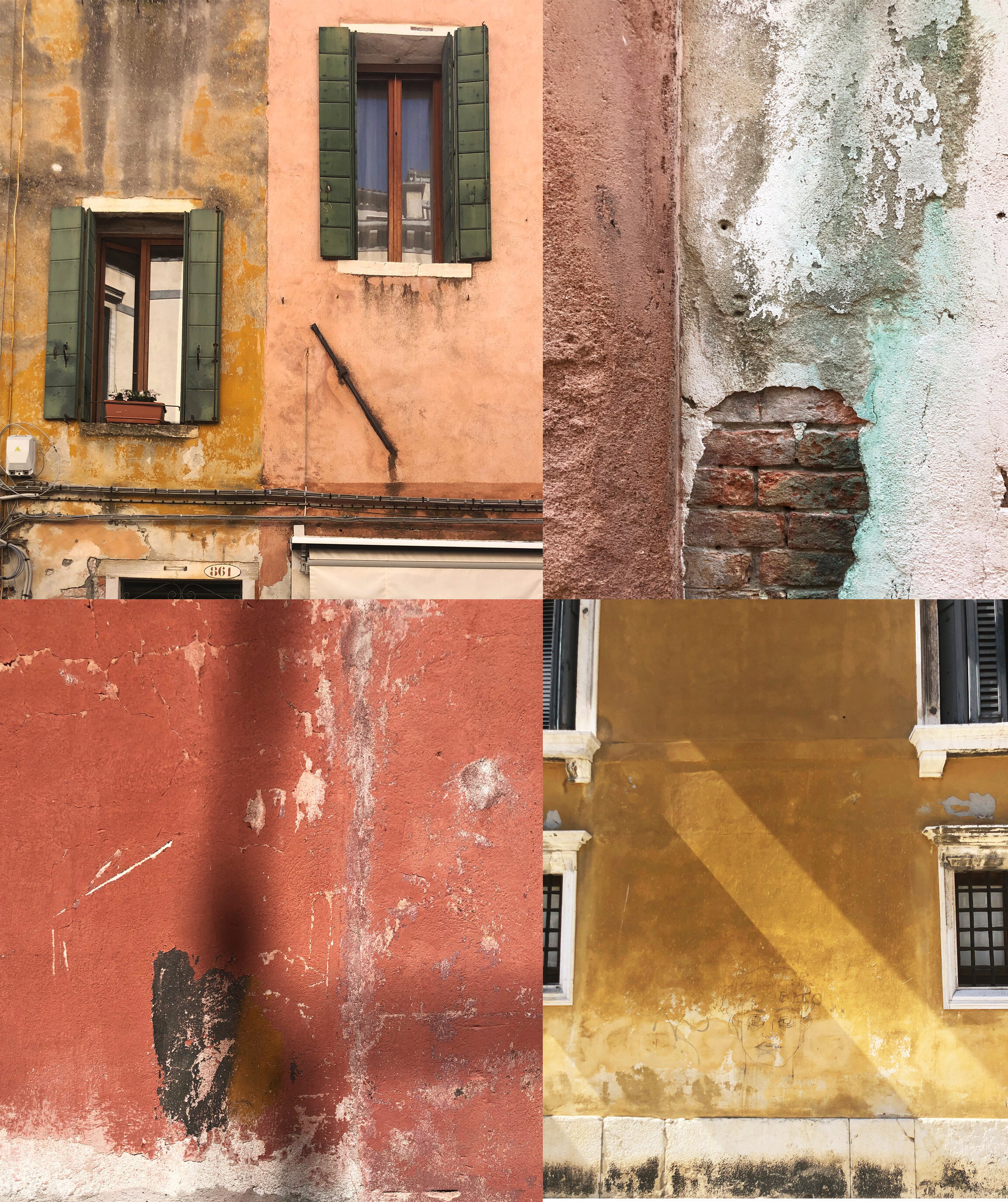The floating city of Venice, Italy is a living museum of found paintings.
A Collection of Walls Found in Venice, Italy, September 2019
I found the walls in Venice to sit proudly in elegant decay, wearing their histories in the patina and faded colors of peeling and chipped paint with poignant adversity.
The resulting textures mark the passage of time and the effects of an incessant number of tourists and the dangerous rising water of the Adriatic Sea’s high tide.
Out of one of the few newspapers I found written in both Italian and English, I read an article, “Venice 2019 Annual Report,” by Gherardo Ortalli, reporting that per one Venetian resident there are 358 tourists, myself included.
Like many other tourists, my reason for visiting was to see the Venice Biennale, aka the Olympics of art. Held biannually in odd numbered years, La Biennale Di Venezia dates back to 1895. Now in 2019, this contemporary art exhibition features a continually growing number of international artists, with more countries installing their own national pavilions.
At the 58th National Art Exhibition (11 May - 24 November 2019), titled, “May You Live in Interesting Times,” I noticed a theme of responses to both climate change and migration.
El Anatsui, is one of six featured artists housed in the Artiglierie section of the Arsenale at the Ghana Pavilion.
Well known for his shapeshifting tapestries of smashed bottle-caps and other recycled detritus, Anatsui’s largest piece featured at the pavilion is a vivid yellow, larger-than-the-wall piece, that references the damage gold panning has wrought on Ghana’s rivers.
Throughout Anatsui’s work there is a clever multi-faceted use of material that simultaneously comments on reclaiming discarded goods out of necessity while referencing both political and historical concerns.
Even his use of cropped text from salvaged aluminum, cites Nigerian liquor companies and alludes to the dark history of Colonialism within the production of rum.
The theme of climate change was addressed directly at the Nordic Pavilion’s exhibition, “Weather Report: Forecasting Future.” Featured above is the work of the artist collective, Nabbteeri, and Ingela Ihrman.
“ It is often difficult for humans to notice life that exists on a scale different from theirs, such as microscopic organisms, the slow workings of toxic agents or durational processes of decaying organic matter. The exhibition attempts to establish a connection with more-than-human agencies by heightening the visitors’ awareness of the materiality, including that of the space and the artworks, and by assimilating their bodies to other life forms.
-Curatorial Statement by Leevi Haapala & Pila Oksanen
Artist, Laure Prouvost featured at the French Pavilion, presented “Deep See Blue Surrounding You / Vois Ce Bleu Profond Te Fondre,” as what I interpreted as a response to the location of Venice as a floating city, surrounded by water.
The exhibition requires you to enter from the basement at the back of the building, leading you up a staircase to a brightly lit room filled with glass imitations of trash imbedded into the sea-like floor. In my book, Prouvost won the award for creating the most encapsulating multi-sensory environment filled with surreal immersions of projected moving images and sounds.
“Written in Water,” by Marco Godinho at the Luxembourg Pavilion also comments on the theme of water and man’s use of the sea to migrate.
Seascapes become mindscapes, metaphors and memories of journeys both traveled and not.
Christoph Büchel’s Barca Nostra at the Venice Biennale
Controversially addressing migration via sea, is Swiss artist, Christoph Büchel’s project “Barca Nostra,” featuring the shipping vessel that sunk in 2015 while carrying hundreds of people fleeing Libya to Italy.
The choice to display the boat as part of the Biennale has been criticized on a spectrum of grossly insensitive to “a sign of signs.” British art critic Matthew Collings explained in the Evening Standard, that the boat’s presence is a symbol of privileged exploits and the continually increasing migrant crisis.
“Venice is replete with visible reminders of militarism, colonialism and looting. The Arsenale is where Venice’s coast guard is based. One of their tasks is to keep migrants out.
Found at the off sight exhibition, “Personal Structures,” Federico Uribe, transforms two entire rooms with his installation, “Plastic Reef.” It’s purpose is obvious, but the sheer amount of tiny bits of plastic texture still manages to surprise you.
The only thing not surprising was encountered this exhibition at the same time as a class of lower school students.
Otobong Nkanga at the Giardini
Otobong Nkanga is one of my favorite finds at the Giardini.
“She describes her drawings as coming from a place of imagination; where realities that are happening in multiple places can intersect. Yet, while her approach may be imaginative, her subjects also reference the very real (and often violent) movement and exchange of minerals, energy, goods and people. They are a reminder that objects and actions do not exist in isolation: there is always a connection, always an impact.”
-Curatorial Statement from the Giardini
Not all of these profiled pieces are works that I enjoyed, but after experiencing them at the Biennale, I’m still thinking about them now.
And I hope that today, as people around the world participate in youth led protests against climate change, that you will also think about your part in what you can do to help.
























